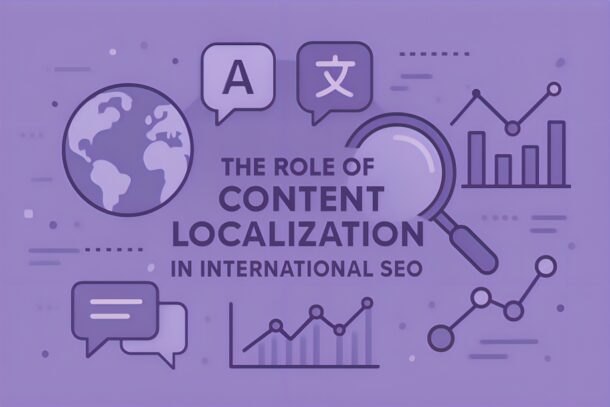Introduction
In today’s globalized digital marketplace, businesses aiming to expand across borders must do more than simply translate their content. They need to adapt it thoughtfully to different cultures, languages, and consumer preferences. This process, known as Content Localization, plays a vital role in international search engine optimization (SEO). By bridging cultural and linguistic gaps, businesses can enhance their visibility, attract more international customers, and foster genuine trust.
However, succeeding in international SEO requires much more than creating multilingual websites. It involves careful adaptation of tone, cultural nuances, user behavior, and search engine algorithms in target markets.
What is Content Localization?
At its core, Content Localization is the practice of adapting digital content for specific regions while preserving the original intent, style, and brand message. Unlike simple translation, localization ensures that content feels natural and relatable to local audiences.
This may involve:
-
Adjusting currency formats, units of measurement, and date formats.
-
Incorporating local cultural references, idioms, and expressions.
-
Aligning with region-specific legal requirements and user preferences.
Ultimately, localization makes content more accessible and relatable, which directly improves global SEO results.
Why Content Localization Matters for International SEO
For companies looking to compete in foreign markets, content tailored to local needs is a powerful differentiator. Search engines prioritize relevance, and localized content signals that a brand is genuinely serving the needs of a region.
Here are a few compelling reasons why localization matters:
-
Improved visibility in local searches: Content tailored with local keywords increases the chance of ranking higher.
-
Enhanced user trust: Customers feel valued when they see content aligned with their cultural expectations.
-
Better conversion rates: A localized website reduces confusion and increases the likelihood of purchases.
Moreover, localized content boosts brand reputation by showing commitment to serving diverse audiences.
SEO Benefits of Content Localization
Integrating localization into international SEO strategies offers multiple advantages:
-
Increased Keyword Relevance
Localized keyword research identifies terms used specifically in target regions, ensuring higher search visibility. -
Lower Bounce Rates
When content resonates with cultural and linguistic expectations, users are more likely to stay and explore. -
Higher Engagement
Personalized experiences encourage interactions such as clicks, sign-ups, or purchases. -
Enhanced Link-Building Opportunities
Region-specific publications and influencers are more inclined to link to content that feels tailored to their audience. -
Stronger Competitive Edge
Companies that invest in localization outperform global competitors who only rely on generic translated material.
Key Elements of Effective Content Localization
While localization requires effort, the impact on international SEO is profound. To maximize results, focus on the following essential elements:
-
Cultural Sensitivity: Ensure content respects traditions, customs, and values.
-
Local Keywords: Conduct keyword research specific to each region instead of directly translating existing keywords.
-
User Experience Adaptation: Design layouts and visuals that align with local preferences.
-
Compliance with Local Regulations: Adapt legal disclaimers, privacy policies, and product information where necessary.
-
Platform Optimization: Optimize content for platforms popular in specific regions, such as Baidu in China or Yandex in Russia.
Challenges in Implementing Content Localization
Although the benefits are substantial, businesses face certain challenges:
-
Cost and Resource Allocation: High-quality localization requires expertise, technology, and cultural insight.
-
Maintaining Brand Consistency: Adapting content while preserving brand voice can be difficult.
-
Technical Complexities: Managing multilingual SEO, hreflang tags, and local hosting may become complex.
-
Continuous Updates: Local markets evolve quickly, requiring frequent content revisions.
By anticipating these challenges, businesses can develop strategies that balance authenticity with efficiency.
Best Practices for Global Brands
To implement localization effectively, companies should follow proven best practices:
-
Partner with professional linguists and local marketers.
-
Perform in-depth regional keyword research before content creation.
-
Use analytics to track the performance of localized pages and optimize accordingly.
-
Maintain balance between global brand identity and regional adaptations.
-
Utilize scalable tools, such as translation management systems, to enhance efficiency.
These practices ensure that localization efforts not only support SEO but also strengthen brand loyalty worldwide.
Conclusion
As global markets become increasingly interconnected, businesses must go beyond surface-level translation and adopt the more comprehensive process of Content Localization. This approach ensures that digital assets resonate with diverse audiences, improve search visibility, and deliver meaningful engagement.
Forward-looking companies like Insprago demonstrate how effective localization can elevate international growth. In fact, by combining an international SEO content strategy with insights from Dubai creative agencies, brands can position themselves as truly global leaders while still connecting deeply with local audiences.
FAQs
1. What is the difference between translation and localization?
Translation focuses on converting text from one language to another, while localization adapts content to suit cultural, regional, and linguistic expectations.
2. How does localization improve SEO?
Localization ensures that keywords, tone, and cultural nuances align with the target audience. This increases engagement, reduces bounce rates, and boosts rankings in local search engines.
3. When should a business invest in localization?
Businesses should consider localization when expanding into new markets or when analytics show a significant international audience visiting their site.



















